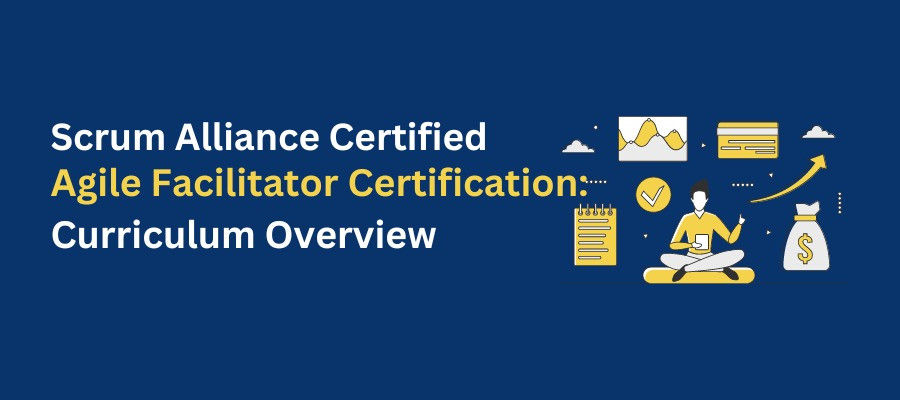Scrum Alliance Certified Agile Facilitator Certification: Curriculum Overview

Becoming an Agile Leader is an achievable goal for any Agile Practitioner like you! The Scrum Alliance Certified Agile Facilitator (CAF) certification is designed for those who want to excel in facilitation skills, making it essential for anyone aiming to lead more effective meetings and ensure all voices are heard.
Whether you're an Agile Coach, a Scrum Master, or an Agile Practitioner, this certification can elevate your facilitation capabilities to new heights. Let's explore the CAF curriculum, what each segment entails, and how it translates into practical implementation.
Setting The Stage: Explore The Scope Of Facilitation In Agile
The journey begins with exploring the definition of Agile Facilitation. In the "Setting the Stage" segment, you learn what facilitation truly means. Facilitation is about guiding a group through interactions that lead to meaningful outcomes. As an Agile beginner or someone already familiar with Agile practices, this segment helps you grasp the foundational concepts.
You'll explore the role of a facilitator. It’s not just about leading meetings. It’s about being a neutral guide who ensures everyone participates and collaborates effectively. This segment sets the tone for the entire course, providing a solid foundation for the advanced techniques you'll learn later.
Understanding the Group’s Context and Needs
Next, we delve into understanding the group’s context and needs. Before any facilitation session, it's crucial to identify the purpose and intended outcomes. This segment teaches you how to assess the environmental contexts and group norms that will impact participation.
During the facilitation, you master focusing only on the group's agenda. It's about practicing ethical facilitation while adapting to the group's dynamics. This knowledge ensures your facilitation efforts are structured and flexible enough to handle real-world scenarios.
The Orientation of a Facilitator
The course then shifts to the orientation of a facilitator. Here, you’ll learn three critical perspectives: from the front, back, and the inside. Facilitating from the front involves understanding why a facilitator needs to orient differently. It’s about leading without dominating. You’ll practice techniques to increase listening skills and effectively deliver feedback.
Facilitating from the back is about fostering a supportive environment. You’ll explore emotional intelligence models and practice techniques to increase self-awareness. This segment emphasizes the importance of a facilitator's presence and how it influences the group’s dynamics. Facilitating from the inside focuses on emotional intelligence, helping you understand your emotions and how they impact your facilitation style.
How To Facilitate Through Conflict
Conflict is inevitable in any group setting. The "Facilitating Through Conflict" segment prepares you to handle it constructively. You’ll learn that conflict is not just expected but necessary for growth. The key is to maintain group positivity and safety within the creative tension.
You’ll explore techniques for navigating conflict without letting it become destructive. This segment equips you with the skills to turn potential conflicts into opportunities for deeper understanding and better outcomes.
Forwarding The Action
Once the session is over, the work doesn't stop. The "Forwarding the Action" segment emphasizes the importance of fostering the group to take decision actions forward. You’ll learn how to derive the expected outcomes using the learnings from the facilitation sessions.
This segment also covers the process of personal and event inspection and adaptation. It's about reflecting on what went well and what can be improved, ensuring continuous improvement in your facilitation practice.
Hands-on Facilitation Practice
The final segment of the CAF certification curriculum mainly focuses on hands-on practice. You’ll model effective facilitation techniques based on the knowledge and skills you’ve acquired throughout the course.
This practical experience is invaluable. You’ll receive feedback and recommendations for improvement, ensuring that you leave the course with theoretical knowledge and practical skills that you can apply immediately as an Agile Leader, Agile Coach, or Scrum Master.
It’s Time For The Practical Implementation of Each Segment
Each segment of the CAF curriculum has practical applications that extend beyond the classroom. When you understand the group's context and needs, you can tailor your facilitation approach to ensure it aligns with the team’s dynamics and goals. This skill is crucial for Agile Training and Scrum Training sessions, where diverse perspectives must be harmonized.
By mastering the orientation of a facilitator, you become adept at balancing leadership and support. So, are you excited to attend the CAF course? Get in touch with PremierAgile coaches to explore the best Agile training scope as per your career aspirations!
Reference:
https://www.scrumalliance.org/get-certified/Agile-coaching-skills/certified-facilitator
https://www.scrumalliance.org/get-certified#facilitationTarget



